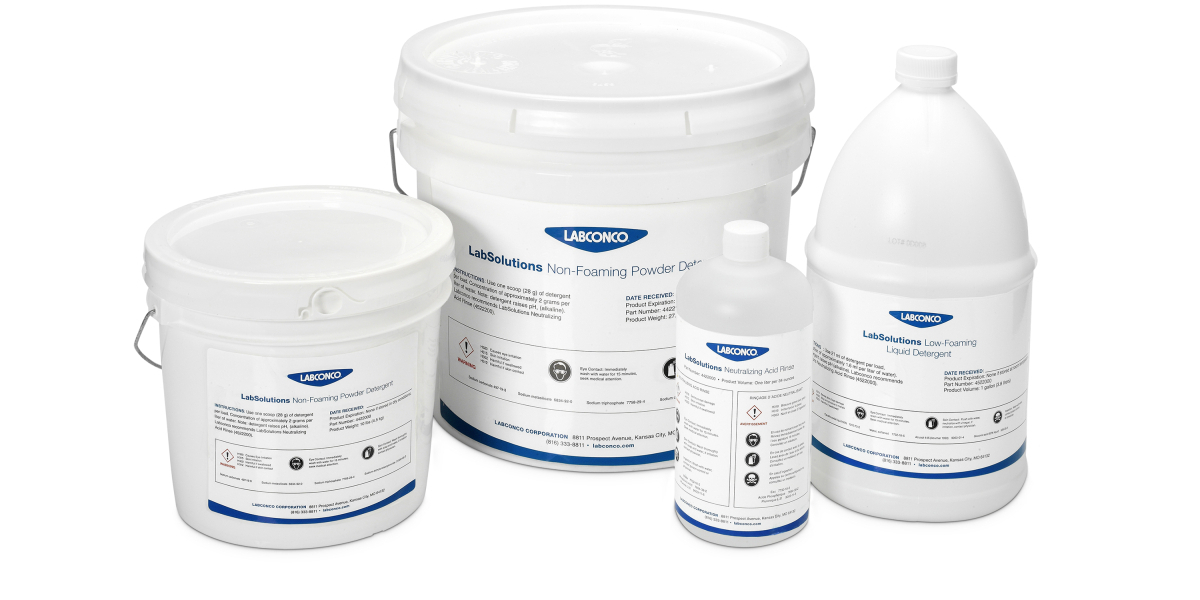Glassware Washer and Detergent – Synergy at its Finest

The laboratory environment is a thriving ecosystem of laboratory professionals and highly sophisticated equipment and workflows. Each component must compliment and enhance the next. Leveraging a glassware washer to reliably produce consistently clean labware is essential to maintaining laboratory quality. Understanding the synergistic relationship that glassware washers have with various detergents will maximize wash results as well as reducing worry about labware cleanliness. Below are brief descriptions of the important components on detergents, a general rule of thumb when selecting a detergent, understanding your substrate needing to be cleaned, and how glassware washers and detergent compliment each other to maximize labware cleanability.
What are surfactants?
Surfactants, also known as surface-active agents, are responsible for lowering the surface tension of water. This is important because lowering the surface of tension allows enhanced wetting and spreading of water molecules. From a chemical composition standpoint, surfactants are amphiphilic, this is due to surfactants being comprised of hydrophobic tails and hydrophilic heads. This molecular composition allows surfactants to form aggregates known as micelles. Micelles are a colloidal suspension that will sequester and disperse soil and other contaminates found on dirty labware.
What are builders?
Another important component of detergents are "builders" and are referred to in general terms are chelators or sequestering agents. Builders simply bind positively charged ions such as calcium (Ca2+) and magnesium (Mg2+). By binding these free cations, builders are responsible for enhancing and promoting the effectiveness of the overall detergent. Another benefits of removing excess free ions from water is that the level of water hardness is reduced greatly.
What are other important components of detergent?
There are other various components of detergent include carriers, solvents, booster, emulsifiers, and enzymes. These important parts of detergent further enhance the chemical breakdown and dispersion of soil and other contaminants on labware. Solvents are often tasked with further reducing the surface tension of water. Boosting elements are incorporate into a wide variety of detergents to optimize the water conditions thereby boosting cleaning performance of the detergent overall. Emulsifiers are specific molecules that can target and breakdown various lipid compounds. Finally, enzymes are often incorporated into detergents to help breakdown and remove stubborn protein and lipid residues.
Is there a general rule of thumb when choosing the right detergent?
Identification of the contaminate is key when selecting a detergent. Various residues and contaminates will respond differently to detergents. Below is a chart that can help cut through the numerous options surrounding laboratory detergents.
|
Type of Cleaner |
pH |
Typical Contaminants |
|
Mineral acids |
0.0-2.0 |
Heavy scales |
|
Mild acids |
2.0-5.5 |
Salts, oxides, metallics |
|
Neutral |
5.5-8.5 |
Light oil and particulates |
|
Mild alkaline |
8.5-11.0 |
Oils and films |
|
Alkaline |
11.0-12.5 |
Natural oil, fat, resin |
|
Corrosive |
12.5+ |
Heavy greases and soils |
Does my substrate matter?
When choosing a detergent understanding the substrate that you are trying to get clean is just as important as understanding the contaminate you are trying to remove. Aluminum and other soft metals are best suited to be washed using detergents that fall between a mild alkaline to modest acid (pH 2.5-9.5). Mild steel, which contains a small percentage of carbon, must be carefully monitored for corrosion by fully rinsing and drying this substrate. Plastics and other plastic polymers are suitable to be washed using a broad range of aqueous cleaners. Stainless steel will benefit from alkaline detergents the most. Finally, borosilicate glass is suitable for a wide range of detergents.
Thermally, mechanically, and chemical cleaning? Why not all three?
Not surprisingly, laboratory detergents are able to provide the chemical cleaning of labware. As outlined previously, several components of detergent function in sequestering or breaking down various residues and contaminates so they can be washed away. The glassware washer is responsible for providing the thermal and mechanical cleaning. More efficient and higher wash water temperatures make it possible to thermally treat stubborn residues so they can be washed away in later rinse steps. Mechanical cleaning is provided by the glassware washer as well. When circulating at a high rate (higher spray pressure), wash water can further dislodge and remove stuck on laboratory contaminates.
The relationship between detergent and glassware washer is an important one. Having a basic understanding of detergents and how it enhances the ability to produce reliable clean labware is fundamental to maintaining quality throughout the laboratory. Additionally, have a solid grasp of heating and circulation rates of your glassware washer are necessary to ensure that strict quality measure found throughout the laboratory environment are met.
| chevron_left | Practically perfect fume hood containment | Articles | Maintaining laboratory equipment during periods of inactivity: Vacuum Pumps and Cold Traps | chevron_right |






